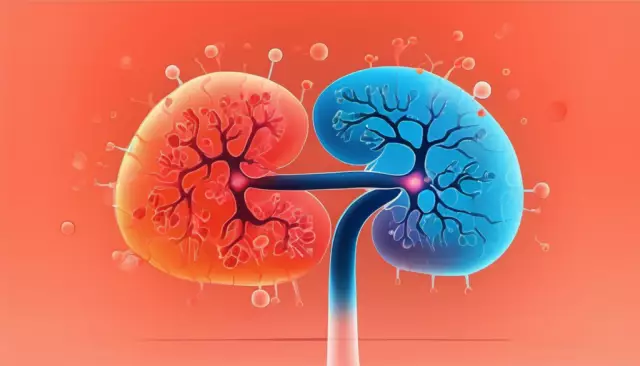- Author Rachel Wainwright [email protected].
- Public 2023-12-15 07:39.
- Last modified 2025-11-02 20:14.
Nephrotic syndrome

Nephrotic syndrome is a disease characterized by severe proteinuria, edema, hyperlipidemia, hypoalbuminemia, increased blood clotting, lipiduria. Due to various immune disorders, metabolic disorders, toxic effects, dystrophic processes in the body, changes in the walls of the glomerular capillaries occur, causing excessive filtration of plasma proteins. Thus, acute nephrotic syndrome is a consequence of pathological conditions leading to increased permeability of the wall of the glomerular capillaries.
The main causes of the development of nephrotic syndrome
Immunological mechanisms play a huge role in the development of nephrotic syndrome. The main reasons for the development of primary neurotic syndrome are:
- mesangial proliferative glomerulonephritis;
- membranous glomerulonephritis (idiopathic nephrotic syndrome in adults);
- membranoproliferative glomerulonephritis;
- lipoid nephrosis (minimal change nephropathy, idiopathic nephrotic syndrome in children);
- focal segmental glomerulosclerosis.
Secondary nephrotic syndrome develops as a result of:
- infectious diseases (leprosy, secondary syphilis, infective endocarditis, hepatitis B, etc.);
- toxic and drug effects (heavy metals, non-steroidal anti-inflammatory drugs, penicillamine, antitoxins, captopril, etc.);
- systemic connective tissue diseases;
- family hereditary diseases;
- other immune diseases;
- amyloidosis;
- rheumatoid arthritis;
- sickle cell anemia;
- diabetes mellitus;
- systemic lupus erythematosus;
- sarcoidosis;
- tumors (leukemia, lymphoma, melanoma, carcinoma, lymphogranulomatosis);
- Schönlein-Henoch disease.
It should be noted that nephrotic syndrome occurs in children about four times more often than in adults.
Symptoms of the nephrotic syndrome
The main clinical symptom of nephrotic syndrome is edema. Swelling can develop gradually, but in some patients, it occurs very quickly. First, they appear in the area of the face, eyelids, lower back and genitals, and subsequently spread to the entire subcutaneous region, often reaching the degree of anasarca. In patients, transudates into serous cavities are observed: ascites, hydrothorax, hydropericardium. The appearance of patients becomes pale, with a puffy face and swollen eyelids. Despite severe pallor, anemia is usually absent or mild.
If a patient develops a symptom of nephrotic syndrome such as renal failure, anemia becomes severe. With ascites, patients complain of indigestion. In patients with hydropericardium and hydrothorax, shortness of breath appears. On the part of the cardiac activity, the following symptoms of nephrotic syndrome are noted: the appearance of a systolic murmur above the apex of the heart, muffled tones, extrasystole, a change in the end part of the ventricular complex, disturbances in the heart rhythm, which in the absence of other heart diseases can be defined as nephrotic myocardial dystrophy resulting from metabolic disorders, electrolyte metabolism and hypoproteinemia.
Acute nephrotic syndrome is characterized by the sudden onset of proteinuria and hematuria. Symptoms of azotemia develop, there is a retention of water and salts in the body, arterial hypertension.
Diagnostics of the nephrotic syndrome
Laboratory findings play a crucial role in the diagnosis of nephrotic syndrome. In nephrotic syndrome, an increased ESR is observed, sometimes up to 50-60 mm in 1 hour. Glomerular filtration is usually normal or slightly increased. The relative density of urine is increased, and its maximum values can reach 1030-1060. Urine sediment is scanty, with a small content of fatty and hyaline casts, fatty bodies. In some cases, microhematuria is observed. In acute nephrotic syndrome that develops in patients with hemorrhagic vasculitis, severe hematuria may be observed against the background of glomerulonephritis or lupus nephropathy.
Actually, the diagnosis of nephrotic syndrome itself does not present any particular difficulties, but the identification of the main cause can give the doctor certain difficulties, since the choice of an adequate treatment for nephrotic syndrome depends on it. In order to identify the cause, the doctor may recommend that the patient undergo a complete clinical, instrumental and laboratory examination.
Course and prognosis of nephrotic syndrome
Many factors determine the complexity of the course and prognosis of this disease. This is the age of patients, the cause of the disease, clinical symptoms, morphological signs, the presence of complications and the adequacy of the treatment of nephrotic syndrome. So, for example, nephrotic syndrome in children (lipoid nephrosis has the most favorable prognosis, since it is prone to remission and responds well to corticosteroids.
The prognosis for primary membranous glomerulonephritis is much worse. As a rule, during the first 10 years, one third of adult patients develop chronic renal failure and, as a result, death. With primary nephrotic syndrome resulting from nephropathy, the prognosis is even worse. For 5-10 years, patients develop severe renal failure, requiring hemodialysis or kidney transplantation, and arterial hypertension. The prognosis of secondary nephrotic syndrome is determined by the course and nature of the underlying disease.
Treatment of nephrotic syndrome
Patients with this disease should observe moderate physical activity, since hypokinesia contributes to the development of thrombosis. A salt-free diet is prescribed, all foods that contain sodium are minimized. The volume of injected fluid should not exceed the daily urine output by 20-30 ml. With a normal total calorie intake, patients are injected with protein at the rate of 1 g per kilogram of weight. Food should be rich in vitamins and potassium.

As a rule, with the onset of renal failure, the edema decreases, then the patient is increased the volume of salt in order to avoid its deficiency, and also allowed to take more fluids. If azotemia is observed, the amount of protein administered is reduced to 0.6 g / kg of body weight per day. Treatment of nephrotic syndrome with albumin is advisable only in patients with severe orthostatic hypotension.
With severe edema, patients are prescribed diuretics. The most effective are ethacrynic acid and furosemide, which are combined with verospiron or triamterene.
Recently, the use of antiplatelet agents and heparin has become widespread in the treatment of nephrotic syndrome, which is especially advisable for patients prone to hypercoagulability.
YouTube video related to the article:
The information is generalized and provided for informational purposes only. At the first sign of illness, see your doctor. Self-medication is hazardous to health!






